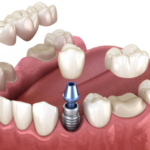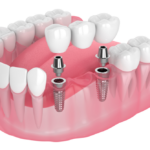Gum recession is defined as when the gum line slowly pulls away from the teeth, revealing more of the tooth or its root. This can result in sensitivity, cavities, or even the loss of a tooth if not taken care of. Gum recession is very common, especially in adults, and it usually occurs so slowly that you don’t even realize it’s happening. Fortunately, you can find periodontics in Airdrie with professionals trained to treat gum issues as gently and effectively as possible.
Let’s look at how periodontists will treat gum recession, as well as what you can expect along the way.
What are the Causes of Gum Recession to Begin With?
A few habits or conditions occur daily that can contribute to gum recession, such as:
- Brushing too hard—If you apply too much pressure or use a toothbrush with hard bristles, you can disrupt gum tissue.
- Poor oral hygiene—Neglecting to brush and floss regularly can allow plaque buildup, which can lead to gum disease.
- Gum disease – One of the most common reasons for gum recession. It damages the tissue where your gums anchor in place.
- Smoking/tobacco use—Both of these products reduce blood flow to the gums, making them much harder to maintain in a healthy state.
- Genetics—Sometimes, gum recession can run in families, even with proper care.
- Teeth grinding or clenching—Putting too much pressure on your teeth can also affect the gums.
How does a Periodontist Examine Receding Gums?
When you visit a dentist in Airdrie for gum recession, they’ll start by checking how far the gums have pulled back. They may:
- Use a special tool to measure gum depth around each tooth.
- Check for plaque, tartar, and signs of infection.
- Ask about your brushing habits, medical history, and symptoms like bleeding or sensitivity.
Once they understand the cause, they’ll decide on the best treatment option for your needs.
What are the Common Treatments Used for Gum Recession?
There are different periodontal procedures for receding gums, depending on how severe the problem is. These may include:
- Deep cleaning (scaling and root planing)—This removes plaque and tartar from below the gumline and smooths the roots so gums can reattach to the tooth.
- Gum grafts—Tissue from another part of your mouth (or donor tissue) is added to cover the exposed root.
- Pinhole surgical technique—A small hole is made in the gum, and special tools are used to loosen and move the tissue to a better position.
- Regeneration procedures—If bone or tissue has been lost, special materials may be placed to help regrowth.
All these treatments aim to stop the gum from pulling back further and help your gums heal and look healthier.
How Periodontists Fix Receding Gums Long-Term?
After treatment, keeping your gums healthy is key. Periodontists usually recommend:
- Regular brushing and flossing with a soft-bristle toothbrush.
- Using antimicrobial mouthwash to reduce bacteria.
- Avoid tobacco to help your gums stay strong.
- Visiting the dentist regularly for cleanings and checkups.
- Wear a nightguard if you grind your teeth at night.
By following these steps, you can prevent the problem from coming back and keep your smile healthy for years.
Your Healthier Smile Starts at Kings Pointe Dental
If you’ve noticed your gums pulling back or your teeth feeling more sensitive, don’t wait. The team at Kings Pointe Dental Centre is here to help you take care of your gum health. Whether you need a deep cleaning or are looking for long-term solutions, our caring team in Airdrie is ready to support your journey.
Book your visit today and take the first step toward a stronger, healthier smile, because your gums deserve the best care possible. Let Kings Pointe Dental Centre help you smile with confidence again!






